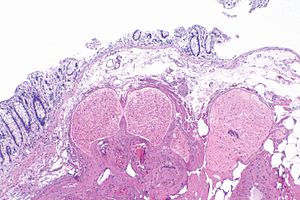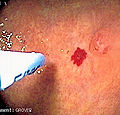Angiodysplasia
Jump to navigation
Jump to search
The printable version is no longer supported and may have rendering errors. Please update your browser bookmarks and please use the default browser print function instead.
| Angiodysplasia | |
|---|---|
| Diagnosis in short | |
 Compatible with angiodysplasia. H&E stain. | |
|
| |
| LM | dilated vessels in mucosa and submucosa |
| LM DDx | prominent vessels |
| Clinical history | older individuals |
| Signs | bleeding from rectum |
| Endoscopy | red lesion - typically right colon or cecum |
| Clin. DDx | Other causes of lower GI bleed |
Angiodysplasia is a benign pathology of the large bowel.
General
- Clinical diagnosis.
- Cause of (lower) GI haemorrhage.
- Generally, not a problem pathologists see.
- May be associated with aortic stenosis; known as Heyde syndrome.[1]
Epidemiology:
- Older people.
Etiology:
- Thought to be caused by the higher wall tension of cecum (due to larger diameter) and result from (intermittent) venous occlusion/focal dilation of vessels.[2]
Gross
- Cecum - classic location.
Note:
- Crohn's disease - may mimic angiodysplasia radiographically.[3]
Images
Microscopic
Features:[3]
- Dilated blood vessels in the mucosa and submucosa.
DDx:
- Crohn's disease - may be associated increase vascularity.
Images
See also
References
- ↑ Hui YT, Lam WM, Fong NM, Yuen PK, Lam JT (August 2009). "Heyde's syndrome: diagnosis and management by the novel single-balloon enteroscopy". Hong Kong Med J 15 (4): 301–3. PMID 19652242. http://www.hkmj.org/abstracts/v15n4/301.htm.
- ↑ Cotran, Ramzi S.; Kumar, Vinay; Fausto, Nelson; Nelso Fausto; Robbins, Stanley L.; Abbas, Abul K. (2005). Robbins and Cotran pathologic basis of disease (7th ed.). St. Louis, Mo: Elsevier Saunders. pp. 854. ISBN 0-7216-0187-1.
- ↑ 3.0 3.1 Hemingway, AP. (Apr 1988). "Angiodysplasia: current concepts.". Postgrad Med J 64 (750): 259-63. PMID 3054852.






